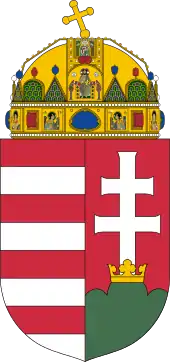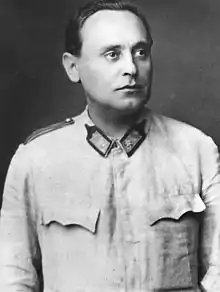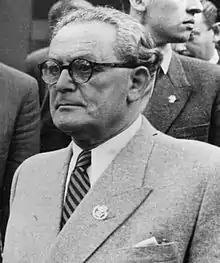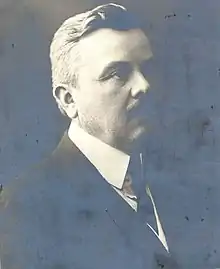1939 Hungarian parliamentary election
Parliamentary elections were held in Hungary on 28 and 29 May 1939.[1] The result was a victory for the Party of Hungarian Life, which won 181 of the 260 seats in Parliament (72 percent of the parliament's seats) and won 49 percent of the popular vote in the election. Pál Teleki remained Prime Minister.[2][3] This was a major breakthrough for the far-right in Hungary;[3] between them, far-right parties were officially credited with 49 seats and 25 percent of the vote.[4]
| |||||||||||||||||||||||||||||||||||||||||||||||||||||||||||||||||||||||||||||||||||||||||||||||||||||||||||||||||||||
All 260 seats in the Diet 131 seats needed for a majority | |||||||||||||||||||||||||||||||||||||||||||||||||||||||||||||||||||||||||||||||||||||||||||||||||||||||||||||||||||||
|---|---|---|---|---|---|---|---|---|---|---|---|---|---|---|---|---|---|---|---|---|---|---|---|---|---|---|---|---|---|---|---|---|---|---|---|---|---|---|---|---|---|---|---|---|---|---|---|---|---|---|---|---|---|---|---|---|---|---|---|---|---|---|---|---|---|---|---|---|---|---|---|---|---|---|---|---|---|---|---|---|---|---|---|---|---|---|---|---|---|---|---|---|---|---|---|---|---|---|---|---|---|---|---|---|---|---|---|---|---|---|---|---|---|---|---|---|---|
| Turnout | 84.4% | ||||||||||||||||||||||||||||||||||||||||||||||||||||||||||||||||||||||||||||||||||||||||||||||||||||||||||||||||||||
| |||||||||||||||||||||||||||||||||||||||||||||||||||||||||||||||||||||||||||||||||||||||||||||||||||||||||||||||||||||
| |||||||||||||||||||||||||||||||||||||||||||||||||||||||||||||||||||||||||||||||||||||||||||||||||||||||||||||||||||||
 |
|---|
| This article is part of a series on the politics and government of Hungary |
|
|
This was the closest thing to a free election that Hungary had seen at that point. According to historian Stanley G. Payne, the far right bloc would have almost certainly won more seats had the election been conducted in a truly fair manner, and possibly garnered an "approximately equal" seat count and vote share with the Party of Hungarian Life.[5]
Electoral system
The electoral system was changed from that used in 1935. The number of single-member constituencies was reduced from 199 to 135, whilst the number of multi-member constituencies was raised from 11 to 38.[6][7] Additionally, the franchise had been significantly expanded, with all men over 26 and all women over 30 now allowed to vote.[5]
Results
| Party | SMCs | MMCs | Total | |||||||
|---|---|---|---|---|---|---|---|---|---|---|
| Votes[a] | % | Seats | Votes[b] | % | Seats | Votes | % | Seats | +/– | |
| Party of Hungarian Life | 766,694 | 51.3 | 112 | 1,057,879 | 48.2 | 69 | 1,824,573 | 49.5 | 181 | +17 |
| Independent Smallholders Party | 228,571 | 15.3 | 1 | 340,483 | 15.5 | 13 | 569,054 | 15.4 | 14 | –8 |
| Arrow Cross Party | 192,356 | 12.9 | 7 | 338,049 | 15.4 | 22 | 530,405 | 14.4 | 29 | New |
| Social Democratic Party | 12,630 | 0.8 | 0 | 113,607 | 5.2 | 5 | 126,637 | 3.4 | 5 | –6 |
| United Hungarian National Socialist Party | 54,887 | 3.7 | 3 | 23,919 | 1.1 | 1 | 78,806 | 2.1 | 4 | New |
| National Front | 28,341 | 1.9 | 2 | 36,014 | 1.6 | 1 | 64,355 | 1.7 | 3 | New |
| Civic Freedom Party | 873 | 0.1 | 0 | 57,766 | 2.6 | 5 | 58,639 | 1.6 | 5 | – |
| Christian National Socialist Front | 40,114 | 2.7 | 1 | 47,419 | 2.2 | 2 | 57,533 | 2.4 | 3 | New |
| United Christian Party | 19,970 | 1.3 | 3 | 36,973 | 1.7 | 1 | 56,943 | 1.5 | 4 | –11 |
| Unofficial Party of Hungarian Life candidates | 46,802 | 3.1 | 0 | – | – | – | 46,802 | 1.3 | 0 | –6 |
| Hungarian National Socialist Agricultural Labourers' and Workers' Party | 13,010 | 0.9 | 1 | 23,127 | 1.1 | 2 | 36,137 | 1.0 | 3 | New |
| National Reform Party | 4,489 | 0.3 | 0 | 17,633 | 0.8 | 0 | 22,122 | 0.6 | 0 | New |
| Christian National Independence Party | – | – | – | 14,024 | 0.6 | 0 | 14,024 | 0.4 | 0 | New |
| Hungarian National Socialist Party | 10,872 | 0.7 | 0 | – | – | – | 10,872 | 0.3 | 0 | –2 |
| People's Will Party | 8,970 | 0.1 | 1 | – | – | – | 8,970 | 0.2 | 1 | 0 |
| National Smallholders, Craftsmen and Workers Party | 6,110 | 0.4 | 0 | – | – | – | 6,110 | 0.2 | 0 | New |
| Independent People's Party | – | – | – | 3,568 | 0.2 | 0 | 3,568 | 0.1 | 0 | New |
| National Agricultural Labourers, Craftsmen and Workers Party | 3,453 | 0.2 | 0 | – | – | – | 3,453 | 0.1 | 0 | New |
| Christian Opposition | – | – | – | 2,384 | 0.1 | 0 | 2,384 | 0.1 | 0 | –1 |
| Hungarian Racist Party | 1,288 | 0.2 | – | – | – | 1,288 | 0.0 | 0 | New | |
| Independents | 22,898 | 1.5 | 4 | – | – | 4 | 22,898 | 6.2 | 8 | –2 |
| Invalid/blank votes | 70,581 | – | – | 150,938 | – | – | 221,519 | – | – | – |
| Total | 1,546,130 | 100 | 135 | 2,343,992 | 100 | 125 | 3,908,122 | 100 | 260 | +15 |
| Registered voters/turnout | 1,719,221 | 91.0 | – | 2,636,557 | 88.9 | – | 4,355,778[c] | 89.7 | – | – |
| Source: Nohlen & Stöver | ||||||||||
a The number of votes refers to only 125 of the 135 single-member constituencies, as 10 seats were uncontested.[6]
b The number of votes refers to 36 of the 38 MMCs as two were uncontested.[6]
c The total number of registered voters was 4,629,493; the figure in the table refers to the number of registered voters in the contested seats.[6]
References
- Dieter Nohlen & Philip Stöver (2010) Elections in Europe: A data handbook, p899 ISBN 978-3-8329-5609-7
- Nohlen & Stöver, p940
- Georgi Karasimeonov. Cleavages, parties, and voters: studies from Bulgaria, the Czech Republic, Hungary, Poland, and Romania. Greenwood Publishing Group, 1999. Pp. 70.
- Payne, Stanley G. (1996). A History of Fascism, 1914-1945. Routledge. p. 275. ISBN 0203501322.
- Payne, p. 275
- Nohlen & Stöver, pp920-921
- Nohlen & Stöver, p933




